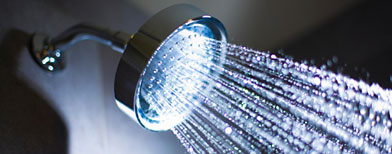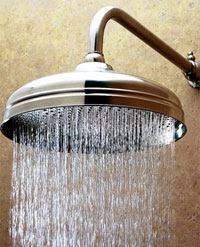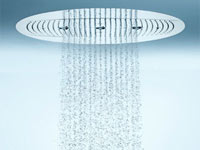A Water Fight Over Luxury Showers
 Gene Goforth sells showerheads—big ones, like the Raindance Imperial 600 AIR. Selling for as much as $5,457, it has a 24-inch spray face, 358 no-clog channels and a triple-massage option. “You can just stand under it, and it helps your psyche,” says Mr. Goforth, who has one in his home.
Gene Goforth sells showerheads—big ones, like the Raindance Imperial 600 AIR. Selling for as much as $5,457, it has a 24-inch spray face, 358 no-clog channels and a triple-massage option. “You can just stand under it, and it helps your psyche,” says Mr. Goforth, who has one in his home.
Now, Mr. Goforth is in a lather over the federal government’s tough new line on water-hogging showerheads, part of a new effort to enforce energy- and water-use regulations. “Leave my shower alone,” Mr. Goforth recently wrote in a letter to the Department of Energy.
Regulators are going after some of the luxury shower fixtures that took off in the housing boom. Many have multiple nozzles, cost thousands of dollars and emit as many as 12 gallons of water a minute. In May, the DOE stunned the plumbing-products industry when it said it would adopt a strict definition of the term “showerhead” in enforcing standards that have been on the books—but largely unenforced—for nearly 20 years.
Industry response has been fast and furious. “It was not the legislative intent of Congress to authorize DOE to regulate the bathing habits of Americans,” wrote Frederick Desborough, vice president of California Faucets, a Huntington Beach, Calif., manufacturer, in a letter to the DOE in June.
The showdown is a challenge to President Barack Obama and his energy secretary, Steven Chu, as they try to cajole—or compel—Americans to use water and energy more efficiently. Mr. Chu, a self-described “zealot” for energy efficiency, says he crawls around in his attic in his spare time installing extra insulation.
 Altmans Products |
| Shower Rose |
A 1992 federal law says a showerhead can deliver no more than 2.5 gallons per minute at a flowing water pressure of 80 pounds per square inch. For years, the term “showerhead” in federal regulations was understood by many manufacturers to mean a device that directs water onto a bather. Each nozzle in a shower was considered separate and in compliance if it delivered no more than the 2.5-gallon maximum. But in May, the DOE said a “showerhead” may incorporate “one or more sprays, nozzles or openings.” Under the new interpretation, all nozzles would count as a single showerhead and be deemed noncompliant if, taken together, they exceed the 2.5 gallons-a-minute maximum.
In May, the DOE’s general counsel, Scott Blake Harris, fined four showerhead makers $165,104 in civil penalties, alleging they failed to demonstrate compliance for some devices.
Manufacturers and retailers say the new rules affect not just upscale systems but also those with hand-held sprays used by the elderly and disabled. Multiple showerheads often found in shower rooms at schools or gyms could also be at risk, manufacturers say. Customers will be disgruntled because of limited product range, they add.
“Did Congress limit consumer choice? Absolutely,” the DOE’s Mr. Harris says. “When you waste water, you waste energy.” Each multi-head shower fixture uses an extra 40 to 80 thermal units of energy per year, equivalent to 50 gallons of gasoline, or one barrel of oil, he says.
 Hansgrohe |
| The Raindance costs up to $5,457. |
Mr. Harris says only manufacturers are subject to the new rules; homeowners aren’t directly affected. Companies will have time to adjust product lines, and most consumers won’t feel any effect, he says. “Ninety-five percent of us use normal showerheads,” he adds.
From 1% to 4% of new homes built in the U.S. has a multi-head shower system, the Plumbing Manufacturers Institute estimates. The industry is “committed to bringing to market water-efficient plumbing products,” says Barbara Higgens, executive director. Mr. Harris is making “a value judgment,” she adds. “One person’s waste is another person’s therapeutic use of water.”
Hansgrohe AG, of Germany, says its Raindance device meets the current 2.5-gallons-per-minute standard but would violate the proposed new definition of showerhead. It will “negatively impact an already weakened American industry, just as it begins to experience signs of recovery,” the company said in a June 18 letter to the DOE.
Altmans Products, a U.S. unit of Grupo Helvex of Mexico City, says it got a letter from the DOE in January and has stopped selling several popular models, including the Shower Rose, which delivers 12 gallons of water a minute. Pedro Mier, the firm’s vice president, says his customers “just like to feel they’re getting a lot of water.” Until getting the DOE letter, his firm didn’t know U.S. law limited showerhead water usage, Mr. Mier says. “At first, I thought it was a scam.”
Corrections & Amplifications
Barbara Higgens is the executive director of the Plumbing Manufacturers Institute. A previous version of this article misspelled her last name.
